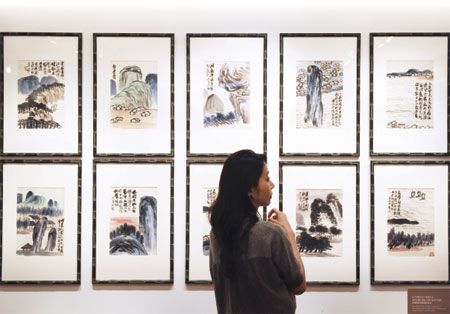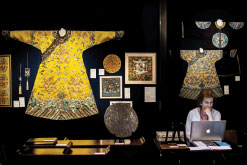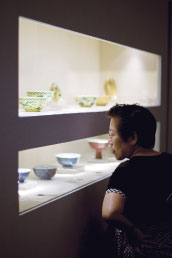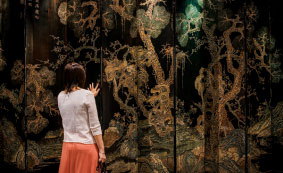In the market for art
Updated: 2012-11-15 07:02
By Zhang Kun(HK Edition)
|
|||||||||
|
A woman inspects artwork by Chinese artist Qi Baishi entitled Landscapes during a China Guardian auction preview in Hong Kong. Dale De La Rey / AFP |
|
An exhibitor uses a laptop at a booth of an art fair in Kong Kong in October. Philippe Lopez / AFP |
|
A woman views some of the ceramic pieces on display at a Christie's Spring Auction in Hong Kong. Daniel J. Groshong / Bloomberg |
|
A visitor looks at a coromandel Chinese lacquer from the Qing Dinasty Kangxi period at a fine art fair in Kong Kong. Philippe Lopez / AFP |
Auction companies from the mainland are joining the thriving Asian art trading market in Hong Kong, bringing their expertise in Chinese art and their wealthy nouveau riche clientele from the mainland. Zhang Kun reports.
China Guardian Auctions, the third largest auction house in the world, held its debut auction in Hong Kong on Oct 7. Poly Auctions, another major player in the mainland art trade, will make its inaugural sale in late November.
Beijing Council International Auction Company, A&F Auction and Beijing Rongbao Auction also aim to enter Hong Kong in the next one or two years.
Poly Auctions will present about 400 pieces for its inaugural auction on Nov 23-25, all of which have been assembled from overseas, according to its Executive President Zhao Xu.
The schedule is in direct conflict with Christie's autumn sale on Nov 23-28.
Earlier in October, China Guardian scheduled its debut auction around the same time as Sotheby's autumn sale, held from Oct 5 to 9.
"Some buyers from the mainland, never before showing at any auction events in Hong Kong, appeared at Sotheby's sale," according to Qiu Jiahe, an art market analyst with Shanghai Securities News.
According to Wang Yannan, president of China Guardian, by landing its business in Hong Kong, the company wanted to "learn from the advanced international experience and operations mode, cultivate its international auction skills, and bring richer auctioned pieces and more convenient and satisfactory services to collectors worldwide."
The objective of China Guardian, however, revealed itself in its debut auction catalogue that included work by top-level modern masters such as Qi Baishi and Xu Beihong as well as ancient masters like Wang Jian.
The auction's success was especially noteworthy given the present downturn in the art market, Qiu said. China Guardian's successful inauguration has inspired colleagues on the mainland and also brought fresh blood to the market of Hong Kong, Qiu said.
According Sotheby's estimate, China's auction market in 2012 will go on dropping by about 20 percent, following last year's downturn, ultimately returning to the level of 2010. This is to say total auction sales in China - including Hong Kong and Macao - will amount to 70-80 billion yuan ($11.21-12.82 billion) in 2012.
Sotheby's auction revealed that the price for ceramics has remained stable while contemporary art has experienced a considerable downturn, according to Beijing Times which quoted art connoisseur and investment advisor Liang Xiaoxin.
Latest pieces from overseas are of great importance to China's art market, since the nearly stagnant economy and price re-adjustments have stemmed the flow of new items onto the market.
Some items were auctioned repeatedly - what was sold in Hong Kong during spring auctions, may re-appear at an auction in Beijing or Shanghai a few months later. It has become a bottleneck that is blocking the development of the high-end art market on the mainland, connoisseurs and critics believed.
"We've been assembling art work from foreign countries for years, and overseas Chinese collectors showed great enthusiasm to Chinese dealers," Zhao told China Daily in a telephone interview.
The strong capability to find fresh items - or "raw meat", as the industry calls it - has brought renewed confidence to Chinese auctioneers such as Poly.
"Christie's and Sotheby's have had permanent offices in North American cities such as New York, Los Angeles and Vancouver, but once we went there, about 1,000 people on average would bring their pieces to us every day," Zhao of Poly said. "They trusted dealers from China, because nowadays that's where the market is."
Poly plans to bring out heavy-weight masterpieces such as ink paintings by Zhang Daqian, and oil paintings by Chu The-chun, as well as a series of fine jewelry by Chinese designer Chen Shiying.
China Guardi offered 319 pieces of Chinese painting and calligraphy for its first auction in Hong Kong, selling 85 percent of them, and totaled HK$354 million, almost three times previous estimates. The antique furniture auction that followed sold all but three of the 39 offered pieces.
"This is our first auction outside the boundary of the Chinese mainland," Wang Yannan, president of China Guardian, told the media. "The success greatly boosted our confidence. We plan to make long-term investment and development in Hong Kong and hold regular spring and autumn auctions annually."
By placing fine jewelry and modern oil paintings in its inaugural sale's catalogue, Poly has posed direct challenge to foreign counterparts of Sotheby's and Christie's.
"We have registered an independent company in Hong Kong and plan to develop steadily here," Zhao said. "We have a permanent office in Hong Kong and an international team of experts there. The operational cost is high, but we are determined to make it."
China's art market boomed with its economy since the mid 2000s, and auction companies on the mainland emerged and developed rapidly with it. A Xinhua report citied statistics from Artprice.com that China, in 2011, became the world's largest art market, representing more than 40 percent of global art sales.
Beijing has been the art trading center of the mainland, with China Guardian and Poly playing the leading roles. China doesn't allow foreign auction houses like Sotheby's and Christie's to trade on the mainland unless they have a Chinese partner.
"In the recent years, mainland auction companies surpassed their international counterparts in Hong Kong more than once, and they have nurtured a stable group of newly wealthy collectors," said Cao Junjie, an art market commentator based in Shanghai.
China's auction companies are young compared to their western counterparts. China Guardian is arguably the most established art dealer on the mainland. It's been doing business since 1993. Poly Auctions is a member of the China Poly Group, an SOE (State-owned enterprise) whose core business is international trade and real estate.
Sotheby's and Christie's enjoy history and prestige in Hong Kong, maintaining high operational standards and have become the mature market norm. But Chinese auction companies are catching up quickly.
A Sotheby's staff member used to complain to 21st Century Business Herald that while Sotheby's had to go through many obstacles to enter the mainland market, mainland companies have landed in the Hong Kong market easily.
As a free port, Hong Kong has its duty free advantages and that has played an important part shaping the city's role in the art market. "But if you bring the purchase to the mainland, you are subject to taxation - which can be as high as 26 percent of the purchase price," said Zhao Yong, president of Hosane, a Shanghai-based auction company. "In the long run, this will be a problem."
Christie's has been accused of smuggling by declaring extremely low prices for clients to customs, so they could pay lower taxation when entering the mainland.
Shanghai has played a smaller role in the art market, so far, in comparison to Beijing and Hong Kong, but the city surely has more to offer, Zhao concluded. "The Yangtze Delta has nurtured rich culture in the past centuries, and Shanghai developed an active art market as early as the 1930s. There are loads of treasures hidden among private collections in Shanghai, as well as the neighboring provinces of Zhejiang and Jiangsu. "It takes longer to establish a healthy market ecology, and build trust with collectors."
"Fine art is an extremely scarce resource, and auction talents even more so," said Zhao with Poly. "If we find skilled staff and the right opportunity, we'd like to expand our auction to Shanghai."
Sotheby's established a joint venture in Beijing, Sotheby's (Beijing) Auction Co Ltd. The company has teamed up with Gehua Cultural Development Group, an SOE. The first auction was held on Sep 27, with only one piece on offer, a conceptual sculpture by contemporary artist Wang Huaiqing.
Christie's however, doesn't have any partners on the mainland. It has authorized the Beijing-based Forever International Auction Co to use the trademark of Christie's.
(HK Edition 11/15/2012 page4)



